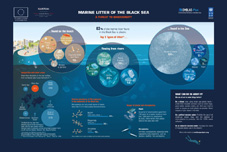
Black Sea twice as polluted as the Mediterranean, biodiversity starts to recover in coastal Georgia
By Nika Gamtsemlidze
Wednesday, August 7
The Black Sea is polluted with hazardous chemicals. According to a study conducted in the framework of Improving Environmental Monitoring in the Black Sea: Selected Measures (EMBLAS-Plus), five factors result in the pollution of the Black Sea.
The study presented in Odessa, a port city on the Black Sea, southern Ukraine, says that the dangerous substances found in the Black Sea include soot, pesticides, insecticides, mercury and flame retardants.
Mostly, the sea is polluted by persistent organic pollutants, metals, pesticides, biocides, pharmaceuticals, flame retardants, industrial pollutants, and personal care products. According to the study, these substances had not been monitored earlier, and they will be proposed to be included for regular monitoring. Also, 124 chemicals dangerous for the sea ecosystem, and human health were identified in the study.
The Joint Black Sea Survey, which the Government of Ukraine is carrying out in accordance with the EU-Ukraine Association Agreement, also found that there is almost twice as much litter in the Black Sea, as in the Mediterranean.
83% of the marine litter found in the Black Sea is plastic, namely bottles, packaging, and bags. The large rivers (in Ukraine study included the Danube and Dniester) bring to the sea from 6 to 50 items of litter per hour.
While presenting the findings of the project, team leader Jaroslav Slobodnik noted that “the obtained results of the surveys should contribute to the development of the evidence-based Programme of Measures to improve the status of the Black Sea, as well as to the global understanding of current risks and threats to marine ecosystems.”
Also, as the study reads, at the moment of the survey (June 2019), at least 1,000 dolphins of each species occurred in Ukrainian territorial waters of the north-western Black Sea, between the Danube Delta and the Tendra Spit in Kherson region. These values are relatively low. The greatest aggregations of dolphins in Ukrainian waters were identified near the Danube Delta and Zmiinyi (Snake) Island.
On the other hand, according to the report, there are also signs of rehabilitation of the Black Sea ecosystem. The biggest red algae field in the world – the Zernov’s Phyllophora Field improved its status from category ‘poor’ to ‘moderate.'
The National Environment Agency, which was involved in the study, said that the Georgian coast is free of chemical contaminants.
The head of the Environmental Pollution and Monitoring Department of the National Environmental Agency Marine Arabidze talked about the situation in territorial waters of Georgia. As she said, “no heavy metals were reported in the territorial waters of Georgia. The fact that we do not have a major, significant problem in the Black Sea region of Georgia is also proven by the fact that biodiversity has begun to recover, the study found some species that have not been recorded before.”
The surveys were held in 2017-2019 in the coastal waters of Georgia, Ukraine, and Russia and the open sea. They were conducted by the EMBLAS – Phase 2 project in cooperation with the Ukrainian Research Center of Ecology of Sea, the Institute of Marine Biology of the National Academy of Sciences of Ukraine as well as Mechnikov National University and others.
The surveys were done following the requirements of the EU Marine Strategy Framework Directive, which is aimed to protect the marine environment across the EU and using the latest monitoring techniques, including non-target chemical screening and e-DNA analysis.


